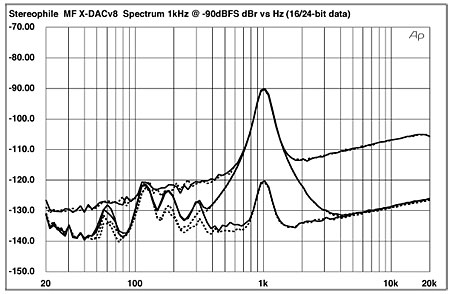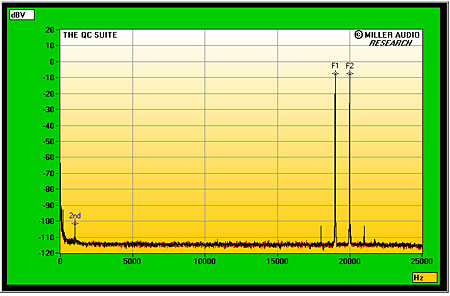| Columns Retired Columns & Blogs |
Musical Fidelity X-DACV8 Digital/Analog Processor Measurements
Sidebar 3: Measurements
I examined the Musical Fidelity X-DACV8's measured behavior before I received our loaner sample of the top-of-the-line Audio Precision SYS2722 system (see the January issue's "As We See It" and www.ap.com). I used two different, older test sets: the National Instruments –based Miller QC Suite and my vintage Audio Precision System One Dual Domain. I performed a complete set of tests from the X-DACV8's solid-state outputs using an S/PDIF link, repeating some of them from the tubed outputs and/or using the USB input.
Looking first at the X-DACV8's performance when fed signals via its conventional S/PDIF inputs, it locked to data with sample rates ranging from 32 to 96kHz. The maximum output level from the solid-state outputs was 2.15V, and an audible 1dB higher from the tube-buffered outputs at 2.42V. Neither output inverted signal polarity, implying that the 6922 tubes are used as cathode followers rather than as voltage amplifiers. The solid-state output impedance was a low 47.5 ohms at high and midrange frequencies, rising inconsequentially to 56 ohms at 20Hz. Switching to the tube buffer, the output impedance actually dropped to 27.5 ohms at 1kHz and 21.5 ohms at 20kHz, but increased to 430 ohms at 20Hz. This is still low in absolute terms, but the tube buffer couldn't deliver enough current into impedances below 1k ohm, with asymmetric clipping evident at levels higher than –5dBFS. If you like the sound of the Musical Fidelity's tubed outputs, make sure your preamp's input impedance is greater than 5k ohms.
The frequency response was identical from the solid-state and tube outputs, and showed a gentle rolloff above the audioband with 96kHz-sampled data, before plunging above 45kHz (fig.1). With CD data, the output was down by just 0.2dB at 20kHz. Channel separation (not shown) was excellent, at >110dB over most of the audioband, and was still almost 100dB at 20kHz.

Fig.1 Musical Fidelity X-DACV8, solid-state output, frequency response at –12dBFS into 100k ohms, with 96kHz data and 44.1kHz data (0.5dB/vertical div., right channel dashed).
Fed dithered 16-bit data representing a 1kHz tone at –90dBFS, the Musical Fidelity decoded the tone with zero level error and a noise floor that was basically that of the recorded dither noise (fig.2, top pair of traces). Increasing the input word length to 24 bits dropped the noise floor in solid-state mode by a superb 22dB (fig.2, middle traces), implying that the X-DACV8's resolution is almost 20 bits —excellent performance for an affordable D/A processor. However, the drop in the signal's self-noise unmasked some power-supply spuriae at 60Hz and its harmonics. The half-wave –rectified 120Hz component was the highest in level, at –122dB, but this is still negligible in absolute terms. Changing to a tone at –120dBFS gave the bottom pair of traces in fig.2. The signal is cleanly resolved by the X-DACV8, with no harmonic content visible.

Fig.2 Musical Fidelity X-DACV8, solid-state, 1/3-octave spectrum with noise and spuriae of (from top to bottom at 3kHz): dithered 1kHz tone at –90dBFS with 16- and 24-bit data; dithered 1kHz tone at –120dBFS with 24-bit data (right channel dashed).
Plotting the X-DACV8's linearity error with 16-bit data really shows only the contribution of the recorded dither noise (fig.3). With its negligible linearity error and low noise, the processor's reproduction of an undithered tone at exactly –90.31dBFS was excellent, with the three DC voltage levels well resolved (fig.4). Switching to 24-bit data gave a good-looking sinewave (fig.5).

Fig.3 Musical Fidelity X-DACV8, left-channel departure from linearity, 16-bit data (2dB/vertical div.).

Fig.4 Musical Fidelity X-DACV8, waveform of undithered 1kHz sinewave at –90.31dBFS, 16-bit data.

Fig.5 Musical Fidelity X-DACV8, waveform of undithered 1kHz sinewave at –90.31dBFS, 24-bit data.
As is typical of Musical Fidelity products, the solid-state outputs of the X-DACV8 offer very low levels of harmonic (fig.6) and intermodulation (fig.7) distortion, with all spuriae at or below –10dB (0.001%), at least in the left channel. The right channel (fig.6, red trace) had a touch more second harmonic, at –91.5dB (0.0025%). This is of only academic interest.

Fig.6 Musical Fidelity X-DACV8, solid-state, spectrum of 1kHz sinewave at 0dBFS into 8k ohms (black, left; red, right; linear frequency scale).

Fig.7 Musical Fidelity X-DACV8, solid-state, HF intermodulation spectrum, 19+20kHz at 0dBFS peak into 8k ohms (black, left; red, right; linear frequency scale).
However, this superb circuit linearity was degraded when the tube buffer was switched in. For reference, fig.8 shows the spectrum of the X-DACV8's solid-state left-channel output reproducing a full-scale low-frequency (50Hz) tone into 100k ohms. Allowing for the different measurement system, it is basically the same as the spectrum in fig.6. For comparison, fig.9 shows the effect of switching in the tube buffer. Some low-order harmonics make an appearance, with the third harmonic the highest in level at –77dB (0.015%). The noise floor also rises in tubed mode, the unweighted audioband signal/noise ratio (ref. 0dBFS) measuring 88dB compared with the superb 104dB without the tube buffer in circuit.

Fig.8 Musical Fidelity X-DACV8, solid-state, spectrum of 50Hz sinewave at 0dBFS into 100k ohms (linear frequency scale).

Fig.9 Musical Fidelity X-DACV8, tube, spectrum of 1kHz sinewave at 0dBFS into 100k ohms (linear frequency scale).
I assessed the Musical Fidelity's rejection of word-clock jitter using the Miller Analyzer. I like to source the test signal from the RME soundcard in my lab PC for tests of digital processors, using an optical TosLink connection to galvanically isolate the processor under test from the computer's noisy ground. As the X-DACV8 doesn't have a TosLink input, I fed the TosLink connection to a Meridian 518 processor set to do nothing other than convert the optical datastream to electrical. With 24-bit data, the jitter was just 76.1 picoseconds peak –peak and the spectrum was superbly clean (fig.10, black trace). With 16-bit data, the jitter rose to a still very low 149ps, with most of the jitter coming from the lowest-order data-related sidebands at ±230Hz (fig.10, grayed-out trace). More important, the low-frequency random jitter that is characteristic of the Meridian processor and that usually broadens the central peak in this kind of graph was completely eliminated.

Fig.10 Musical Fidelity X-DACV8, solid-state, high-resolution jitter spectrum of analog output signal (11.025kHz at –6dBFS, sampled at 44.1kHz with LSB toggled at 229Hz), 24-bit data sourced from PC via 15' TosLink/Meridian 518/1m coax (grayed-out trace, 16-bit data). Center frequency of trace, 11.025kHz; frequency range, ±3.5kHz.
I tested the Musical Fidelity's USB input using first my 2002-vintage Apple G4 PowerBook running OS10.3.9, USB1.1, Bias Peak 5.2, and iTunes 7.4.2, then my G4 Mac mini running OS10.4.10, USB2.0, and again Bias Peak 5.2 and iTunes 7.4.2. (Once the MF has been plugged in, you need to select "USB Audio Device" in the Mac's Systems Preferences Menu.) The X-DACV8 successfully locked on to sources with sample rates ranging from 32 to 48kHz., but appeared to truncate data with bit depths greater than 16. Sound quality from the PowerBook was okay, though not quite as clean as I was expecting —but given the problems I had getting the Benchmark DAC1 USB to work with the PowerBook (see my review in the January 2008 issue), I wasn't surprised that the X-DACV8's USB input worked better with the Mac mini. It then measured identically to how it had with 16-bit S/PDIF datastreams. But this underlines what I have written before: With music data fed to an external DAC using a USB connection, you have rather too many variables in play to be able to predict the aural outcome, even if you make sure all of iTunes' "enhancements" are turned off.
Used with its solid-state outputs, the Musical Fidelity X-DACV8 is one of the best-measuring D/A processors that has passed through my hands, with very low levels of not only background noise jitter but all kinds of distortion, coupled with very high resolution. Wow! Switching in the tube buffer, however, slightly degrades both the distortion and noise performance, and raises the output level by an audible 1dB. But if that's what floats your boat, who am I to quibble? —John Atkinson
- Log in or register to post comments




































